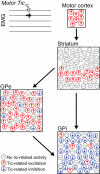Loss of specificity in Basal Ganglia related movement disorders
- PMID: 21687797
- PMCID: PMC3108383
- DOI: 10.3389/fnsys.2011.00038
Loss of specificity in Basal Ganglia related movement disorders
Abstract
The basal ganglia (BG) are a group of interconnected nuclei which play a pivotal part in limbic, associative, and motor functions. This role is mirrored by the wide range of motor and behavioral abnormalities directly resulting from dysfunction of the BG. Studies of normal behavior have found that BG neurons tend to phasically modulate their activity in relation to different behavioral events. In the normal BG, this modulation is highly specific, with each neuron related only to a small subset of behavioral events depending on specific combinations of movement parameters and context. In many pathological conditions involving BG dysfunction and motor abnormalities, this neuronal specificity is lost. Loss of specificity (LOS) manifests in neuronal activity related to a larger spectrum of events and consequently a large overlap of movement-related activation patterns between different neurons. We review the existing evidence for LOS in BG-related movement disorders, the possible neural mechanisms underlying LOS, its effects on frequently used measures of neuronal activity and its relation to theoretical models of the BG. The prevalence of LOS in a many BG-related disorders suggests that neuronal specificity may represent a key feature of normal information processing in the BG system. Thus, the concept of neuronal specificity may underlie a unifying conceptual framework for the BG role in normal and abnormal motor control.
Keywords: Parkinson's disease; Tourette syndrome; basal ganglia; dyskinesia; dystonia; information encoding; movement.
Figures





Similar articles
-
Functional organization of the basal ganglia: therapeutic implications for Parkinson's disease.Mov Disord. 2008;23 Suppl 3:S548-59. doi: 10.1002/mds.22062. Mov Disord. 2008. PMID: 18781672 Review.
-
Functional anatomy of the basal ganglia: limbic aspects.Rev Neurol (Paris). 2012 Aug-Sep;168(8-9):569-75. doi: 10.1016/j.neurol.2012.06.015. Epub 2012 Aug 14. Rev Neurol (Paris). 2012. PMID: 22902172 Review.
-
Dopaminergic denervation impairs cortical motor and associative/limbic information processing through the basal ganglia and its modulation by the CB1 receptor.Neurobiol Dis. 2021 Jan;148:105214. doi: 10.1016/j.nbd.2020.105214. Epub 2020 Dec 3. Neurobiol Dis. 2021. PMID: 33278598
-
Selective dysfunction of basal ganglia subterritories: From movement to behavioral disorders.Mov Disord. 2015 Aug;30(9):1155-70. doi: 10.1002/mds.26199. Epub 2015 Mar 15. Mov Disord. 2015. PMID: 25772380 Review.
-
Disrupted basal ganglia output during movement preparation in hemiparkinsonian mice is consistent with behavioral deficits.J Neurophysiol. 2021 Oct 1;126(4):1248-1264. doi: 10.1152/jn.00001.2021. Epub 2021 Aug 18. J Neurophysiol. 2021. PMID: 34406873 Free PMC article.
Cited by
-
Movement activation and inhibition in Parkinson's disease: a functional imaging study.J Parkinsons Dis. 2013;3(2):181-92. doi: 10.3233/JPD-130181. J Parkinsons Dis. 2013. PMID: 23938347 Free PMC article.
-
Synaptic network structure shapes cortically evoked spatio-temporal responses of STN and GPe neurons in a computational model.Front Neuroinform. 2023 Aug 22;17:1217786. doi: 10.3389/fninf.2023.1217786. eCollection 2023. Front Neuroinform. 2023. PMID: 37675246 Free PMC article.
-
Differential Changes in the Lateralized Activity of Identified Projection Neurons of Motor Cortex in Hemiparkinsonian Rats.eNeuro. 2019 Jul 10;6(4):ENEURO.0110-19.2019. doi: 10.1523/ENEURO.0110-19.2019. Print 2019 Jul/Aug. eNeuro. 2019. PMID: 31235466 Free PMC article.
-
Primary motor cortex of the parkinsonian monkey: altered neuronal responses to muscle stretch.Front Syst Neurosci. 2013 Nov 26;7:98. doi: 10.3389/fnsys.2013.00098. eCollection 2013. Front Syst Neurosci. 2013. PMID: 24324412 Free PMC article.
-
Diametric neural ensemble dynamics in parkinsonian and dyskinetic states.Nature. 2018 May;557(7704):177-182. doi: 10.1038/s41586-018-0090-6. Epub 2018 May 2. Nature. 2018. PMID: 29720658 Free PMC article.
References
-
- Agid Y. (1991). Parkinson's disease: pathophysiology. Lancet 337, 1321–1324 - PubMed
-
- Albin R. L., Mink J. W. (2006). Recent advances in Tourette syndrome research. Trends Neurosci. 29, 175–182 - PubMed
-
- Albin R. L., Young A. B., Penney J. B. (1989). The functional anatomy of basal ganglia disorders. Trends Neurosci. 12, 366–375 - PubMed
-
- Alexander G. E., Crutcher M. D. (1990a). Functional architecture of basal ganglia circuits: neural substrates of parallel processing. Trends Neurosci. 13, 266–271 - PubMed
-
- Alexander G. E., Crutcher M. D. (1990b). Neural representations of the target (goal) of visually guided arm movements in three motor areas of the monkey. J. Neurophysiol. 64, 164–178 - PubMed
LinkOut - more resources
Full Text Sources

